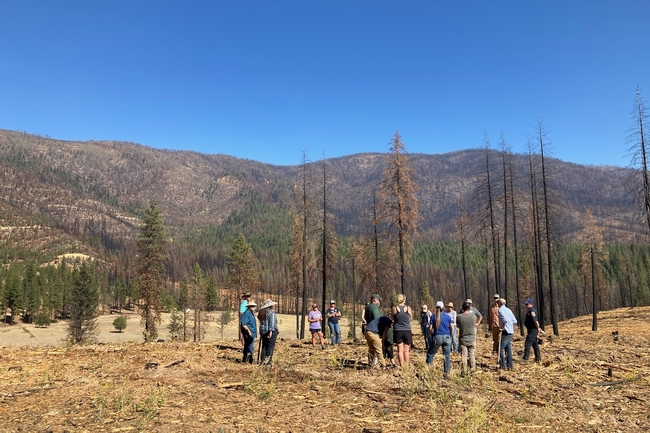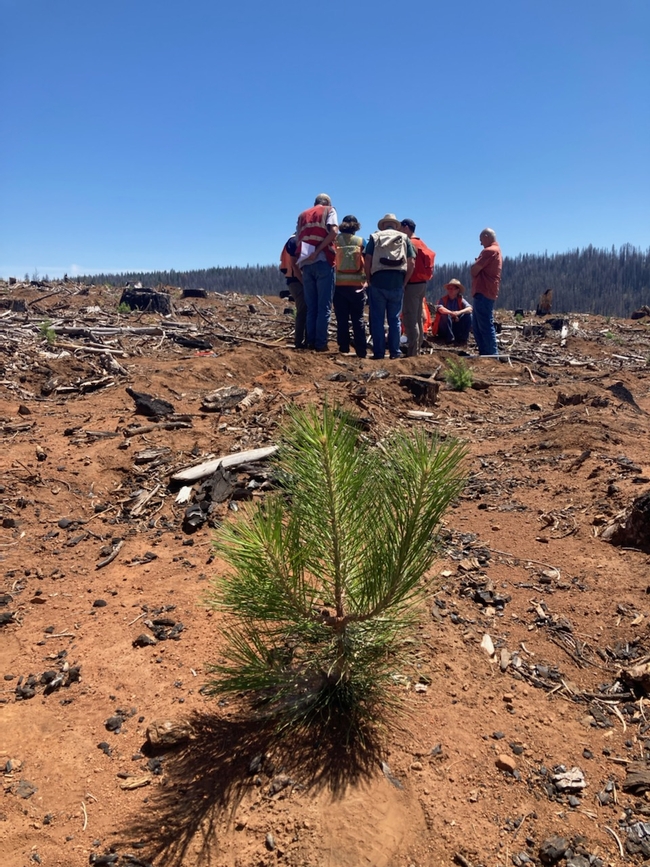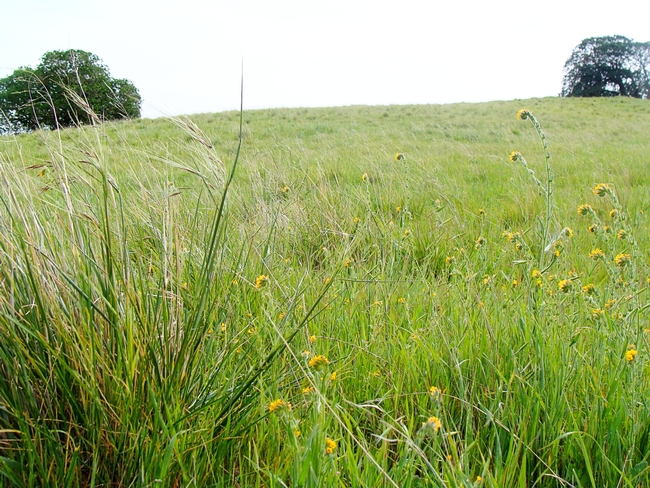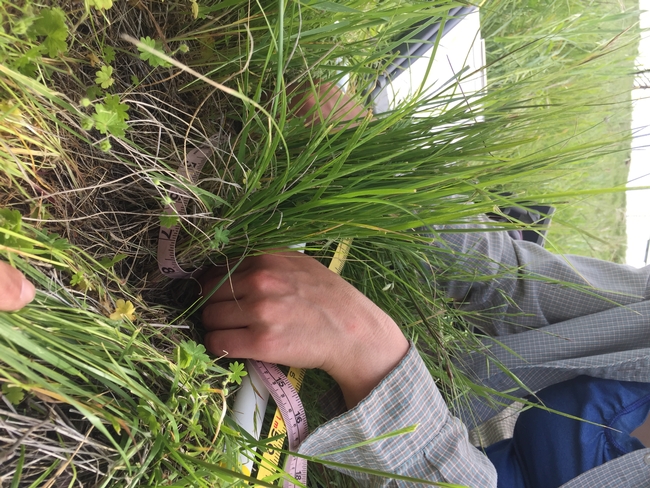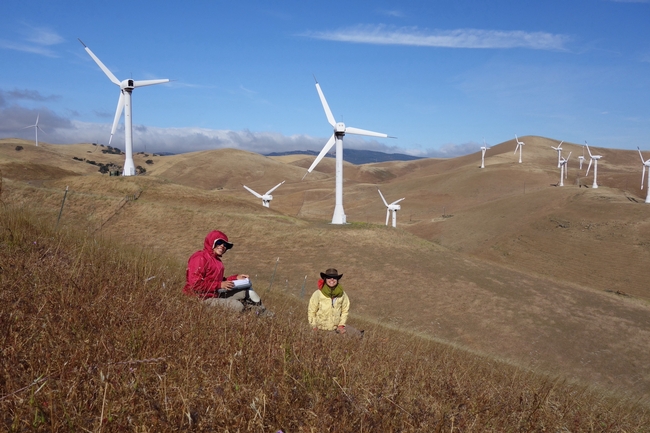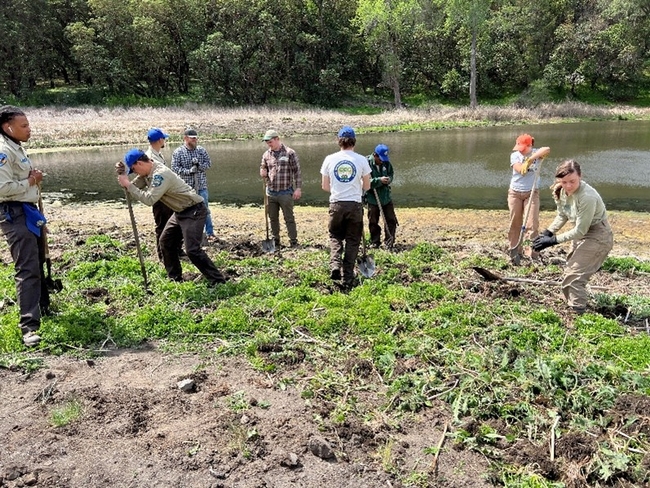
Posts Tagged: Restoration
UCCE report: Local forest restoration teams effective at rapid response
Quickly planting trees after wildfires crucial for communities, ecosystems, carbon goals
As the climate crisis fuels more high-severity wildfires, many forests – adapted to bounce back from frequent but less-intense fires – are struggling to recover quickly.
“In a lot of locations, forests in the Sierra Nevada that burn at high severity are not regenerating on their own,” said Susie Kocher, University of California Cooperative Extension forestry and natural resources advisor for the Central Sierra. “They need to have living trees to drop seeds; if everything dies in an intense fire, then there's a high likelihood in those locations that trees might not return for a while.”
According to Kocher, a forest may take multiple decades to grow back on its own, seeding in very slowly from the edges of a burn. To speed up that regeneration process, a pilot program of local “Emergency Forest Restoration Teams,” or EFRTs, have been helping forest landowners rapidly remove dead trees, plant new seedlings and expedite other vital tasks after wildfires.
Kocher is a co-author of a recently released report evaluating the EFRTs, which appear to be effective in assisting often-overwhelmed private landowners navigate competitive funding programs and complicated permitting pathways after wildfire. Small private landowners in California own 7 million acres, comprising 22% of forested land across the state.
“None of our current assistance programs were really designed to rapidly respond to high-severity fire disasters,” Kocher said. “And we're just getting so much more high-severity fire now that there needed to be a different way of helping people, besides business as usual.”
Lead agencies improve coordination of restoration efforts
Drawing from a successful model in Washington, Kocher and other members of the Governor's Forest Management Task Force recommended the formation of EFRTs in 2019 and this recommendation made it into the California Wildfire and Forest Resilience Action Plan of 2021.
Following the Caldor, Dixie and Tamarack fires during that year, disaster relief funds from CAL FIRE and the U.S. Forest Service enabled the establishment of pilot EFRTs in each of the affected regions. A key innovation was designating a local lead agency to coordinate restoration efforts: the El Dorado Resource Conservation District (Caldor), the Feather River Resource Conservation District (Dixie) and Alpine County (Tamarack).
“The idea is that one well-established local agency gets the funds to carry out all the reforestation work,” Kocher said. “They find contractors for the landowners and plan and carry out all the work needed, including dead tree removal, site preparation and replanting; this helps it be more coordinated across the landscape and reduces competition for contractors.”
“Also, for most of that work, there's no cost to the landowner – which is a huge benefit to them, because these things can get really expensive, like many thousands of dollars an acre,” Kocher added.
Although there was an initial steep learning curve for the local lead agencies on the complexities of reforestation and the maze of required permits, they quickly executed a significant number of forest restoration treatments. Within two years, the three pilot teams had collectively completed over 2,500 acres of dead tree removal and 1,400 acres of conifer planting.
“The overwhelming benefit of the pilots was that a lot of work got done on the ground, that otherwise would not have been done – at least not in the timeframe that was made possible by the EFRTs,” said Daylin Wade, a UCCE staff research associate and co-author of the recent report, who synthesized feedback from interviews of professionals involved in the program.
Rapid reforestation better financially, ecologically
Both Wade and Kocher underscored how the EFRTs were crucial in completing restoration tasks in a timely manner. Removal of dead wood becomes trickier and more expensive over time, as the trees decay and are dangerous to cut down.
“A major accomplishment was getting trees out of there while it was both safe and economically viable to remove those trees – and getting trees in the ground before shrubs dominate the site,” Wade explained.
It's also imperative to quickly remove the dead trees to reduce the fuel load and minimize the chances of re-burn in the area.
“If you're not doing this work, then you're actually endangering the investment that you're putting into rebuilding communities that burned, because they're in danger of burning again if you have huge piles of dead trees everywhere,” Kocher said.
Furthermore, expediting those tasks helps restore the forest cover that is crucial for sequestering carbon and achieving the goals of California's sweeping climate action plan – such as attaining carbon neutrality by 2045.
“We have very ambitious carbon goals for our forests in California, and so reestablishing them – even on private lands – is a public benefit,” Kocher said.
Evaluation of EFRTs by UC Cooperative Extension continues
In addition to enumerating the progress of the three EFRT case studies, the evaluation report also lists recommendations to further enhance the program, such as securing rapid and flexible funding for future EFRTs, improving guidance for local lead agencies and streamlining permitting processes.
The authors also stressed the need to expand opportunities for the commercial sale of woody material in the aftermath of a wildfire event. Selling logs and wood chips reduces the volume of material that would need to processed onsite by the EFRTs and their contractors, thereby defraying some of the costs for that work.
But there simply hasn't been a sufficient market for that woody biomass.
“It's a big barrier,” Kocher said. “If we had a healthier timber market, it would be easier to make this stuff pay its own way and be less of a subsidized endeavor.”
UC Cooperative Extension's EFRT evaluation work – made possible by funding from the U.S. Forest Service State, Private and Tribal Forestry, Region 5 – will continue for the next couple years. On the heels of this first report, Wade will next gather and summarize feedback from private landowners on whether the EFRTs are meeting their goals.
And, later this summer and fall, researchers will begin assessing the ecological success of the plantings in the restoration areas, surveying seedling survival and gauging the volume of competing vegetation.
“It's hugely encouraging that we've gotten all these trees in the ground, but it's not the end of the process – it's just the beginning,” Kocher said. “Trees and forests need to be maintained over time, so this next step will let us see how successful that has been, and if there are additional steps needed to actually ensure that these trees succeed and thrive.”
The full report, dedicated to the memory of report co-author and UCCE advisor Ryan Tompkins, can be found at https://ucanr.edu/efrt.
Valliere brings expertise in restoration ecology
It all started with pumpkin seeds Justin Valliere has been hired to expand the Department of Plant...
The no-tech way to preserve California’s state grass
Disappearing native is like an environmental Swiss Army knife
Though it is disappearing, California's official state grass has the ability to live for 100 years or more. New research demonstrates that sheep and cattle can help it achieve that longevity.
Purple needlegrass once dominated the state's grasslands, serving as food for Native Americans and for more than 330 terrestrial creatures. Today, California has lost most of its grasslands, and the needlegrass occupies only one tenth of what remains.
It is drought resistant, promotes the health of native wildflowers by attracting beneficial root fungi, burns more slowly than non-native grasses and speeds the postfire recovery of burned lands. For these and other reasons, many who work toward habitat restoration hope to preserve the needlegrass.
“Where it grows, these tall, slender bunches become focal points, beautiful as well as environmentally beneficial,” said Loralee Larios, a UC Riverside plant ecologist affiliated with UC Agriculture and Natural Resources. “However, identifying successful management strategies for a species that can live for a couple hundred years is challenging.”
To meet that challenge, Larios teamed up with University of Oregon plant ecologist Lauren Hallett and Northern California's East Bay Regional Park District. They tracked the health of nearly 5,000 individual needlegrass clumps over six years, including an El Niño rain year as well as historic drought.
The researchers took measurements of plant health including growth and seed production. They placed small bags over many of the grass clumps to capture the seeds and quantify the number of seeds they produced.
Their findings, now published in the Journal of Applied Ecology, were that purple needlegrass did better in places where sheep were allowed to graze. The positive effects of the grazing were amplified in times of wetter weather.
Previously, the park district spent a decade trying to assess the success of its grassland maintenance techniques. However, the district's method of applying a strategy like grazing, and then measuring the percentage of needlegrass clumps in a given area resulted in data that didn't follow a discernable pattern from year to year.
“By tracking each plant over time, rather than scanning broadly across an area, we gained much more clarity about how the grass responds to the grazing,” Larios explained. “Perhaps counterintuitively, we saw that the needlegrass generally died back when sheep weren't allowed to graze on it.”
When sheep were removed from the study sites, the needlegrass in all but two of the sites became less healthy. The researchers would like to learn whether the two sites that remained healthy have needlegrasses that are genetically distinct.
Grazing is a controversial strategy for grassland restoration. Some conservationists believe sheep eating the target grass, particularly during already stressful drought years, does not enhance their survival. As far back as the 1800s, some researchers hypothesized that the combination of grazing and drought resulted in the loss of perennial grasses.
Though drought was not beneficial for any of the plants in this study, the researchers believe grazing helped needlegrass survive in at least two ways. One, by trampling on leaf litter and other organic debris, sheep created space for new needlegrass to grow.
“Sometimes you get litter that's as deep as a pencil — so much dead, non-native grass piles up. It's hard for a little seed to get enough light through all of that,” Larios said.
Secondly, sheep eat non-native grasses that generate growth-suppressing debris and compete with purple needlegrass for resources.
When the Spanish colonized California, they brought forage grasses like wild oats that they thought would benefit cattle. Those introduced grasses spread, and now dominate the state's grasslands.
“Our grasslands are known as one of the world's biggest biological invasions,” Larios said.
California has as many as 25 million acres of grasslands, equivalent to the combined areas of Massachusetts, Connecticut, and Rhode Island. Though Larios does not believe it is possible to rid the state of all non-native grasses, she said it is possible to maintain or even increase the amount of purple needlegrass.
“It's great for carbon storage, which mitigates climate change, it doesn't serve as wildfire fuel, and cultivates a space for wildflowers that pollinators are then able to use,” Larios said. “We want to keep all those benefits.”
Bringing back California’s native frogs
When Al Murphy first took the reins at the UC Hopland Research and Extension Center (HREC) back in the 1950s, he had the joy of listening to California red-legged frogs living in a couple of perennial ponds. Maybe it was the frog chorus or just the rarity of year-round water that made Al and his staff decide to keep the sheep out and declare the ponds a biological area. Despite the designation as a biological area, the ponds have lost a good deal of biodiversity since Al's time.
The native frogs took a beating thanks to bullfrogs and exotic fish such as large-mouth bass that were introduced for sport fishing and by the time Kevin Lunde did his Ph.D. on chorus frogs at HREC in 2011, there were no native frogs to be found in the ponds. Also, by removing grazing and the use of fire to manage the rangelands surrounding the ponds, tule reeds dominate the pond's edge and invasive plants such as vetch spread across the higher ground.
The recent periods of drought are devastating for most of California's ecosystems, but were good news for the ponds. They went completely dry for the first time in recorded history, and the largemouth bass died off. The long, dry period also puts us at an advantage for bullfrog eradication while the habitat for the species is limited. As part of the restoration efforts, HREC staff removed some of the bullrush and community volunteers along with members from the California Conservation Corps spent the day translocating spike rush plants from nearby locations to the recently cleared areas along the edge of the pond to provide additional warm, shallow sunning areas for native amphibians.
Only time will tell if the spike rush takes hold and, in the meantime, we hope volunteers will return to help get rid of some bullfrogs. If we can keep the bass out and the bullfrogs under control, we can look forward to a time when red-legged frogs can safely return to HREC.
Thanks, HREC staff and GrizzlyCorps member Mona Latil-Quinn, for your help.
JOB ANNOUNCEMENT :: Assistant Professor of Cooperative Extension in Invasive Weed and Restoration Ecology
The Department of Plant Sciences at the University of California, Davis, seeks an Assistant...

